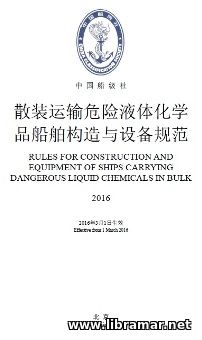 The latest CSS Rules to be used during construction and fitting equipment to the vessels engaged in transportation of dangerous liquid chemical cargoes in bulk form. The content of the rulebook has been developed by the CSS experts in compliance with the technical requirements of the IBC Code adopted by MSC of the IMO by Res. MSC.4.(48) together with the amendments intended for the vessels transporting dangerous liquids in bulk and planned to be classed with China Classification Society.
The Rules are made of three parts and the first part describes the correlation between them and the Code, CCS Rules for Materials & Welding, Rules for Classification of Sea-Going Steel Ships, and other relevant provisions. The second part specifies requirements for the classification and surveys of the vessels carrying the cargoes stated in the Code.
Finally, the third part of the Rules incorporate the complete text of the Code plus amendments as well as the additional paragraphs and interpretations that shall be complied with for the purpose of classification. A needful volume for both inspectors and crew members of the vessels transporting dangerous liquid chemicals and wishing to keep their vessels compliant and ready for survey.
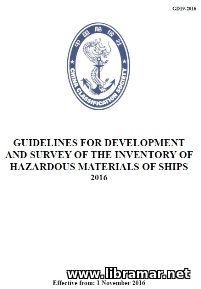 These CCS guidelines have been prepared and released with the intention of the authors to provide required assistance to the relevant parties including owners of the vessels, ship construction yards and suppliers willing to get better understanding of the subject and planning to implement the HK Convention for the Safe and Environmentally Sound Recycling of Ships.
It will also provide the guidance concerning the uniform implementation of ship survey and certification requirements for the CCS surveyors attending the vessels with the GP, i.e. Green Passport, classification notation assigned. The content of the guidebook opens with the brief introductory information about the control of hazardous materials on board ships and the IHM itself.
The general survey and certification information including general requirements, assignment of the associated notations and issuance/endorsement of the certificates is there in the second chapter while the third and fourth chapters are dealing with the development of the IHM for newly delivered and existing ships, covering general requirements and material declaration, supplier's declaration, application for the survey and other aspects.
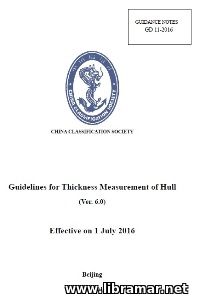 The officially released Guidance Notes for the thickness measurement of the ship's hull developed and released by the China Register of Shipping. Note that this is the latest edition of the guidebook. Hull gauging is considered one of the most important parts of surveys that is why it is critical to conduct the thickness measurement in full compliance with all requirements of the classification society.
The volume starts with general information followed by the chapter providing detailed description of the established working procedures used during the thickness measurements of the hull. The third chapter is dealing with the renewal criteria for the structures in question - this chapter is particularly important for the marine surveyors and inspectors engaged in the evaluation of the condition of the hull and shall be used as the basis when making relevant decisions.
The next four chapters address the technical requirements of CCS for the gauging of different types of vessels including general dry cargo ships, oil tankers, combination carriers, chemical carriers, bulk carriers and others. The closing chapters of the book contain minimum requirements for the liquefied gas ships and selection of the locations where the thickness measurement should be performed.
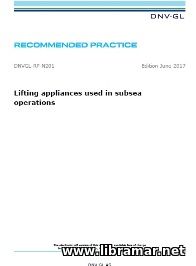 The recommended practice released by DNV GL classification society and dealing with the lifting appliances commonly used for subsea operations. The main principles, objective and application of the document have been delineated in the first introductory chapter. You will also find acronyms and abbreviations used throughout the booklet explained in the same chapter.
The second chapter is devoted to the structure and dynamics including lifting and subsea lifting capacity of the appliances, winches and drums, steel wire and fiber ropes, tugger winches etc., while the third one addresses the control and power systems including electronic and hydraulic installations, safety evaluations and applicable technical requirements together with the documentation.
The next two chapters of the volume deal with the fabrication, inspection, certification and routing technical maintenance of lifting appliances including ropes, sheaves, winches, their certification, and operation matters including personnel qualification, structural design and loads involved, environmental conditions, planning and organization of the operations, HSE management etc. Three appendices to the main content cover the hazards, systems overview and motion compensation systems.
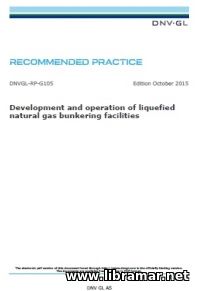 DNV GL issued the present official Recommended Practice in 2015 to cover the development and operation of LNG bunkering facilities. Today, liquefied natural gas fuel is considered a viable option for vessels. It differs from the traditional marine fuels as it features low flash point and also cryogenic temperature. Note, however, that the LNG is not widespread as bunker fuel at the moment.
That is why it is absolutely necessary to have due understanding of all risks normally involved in bunkering operations using liquefied natural gases. The main purpose of this document was to establish required guidelines related to protection of the safety of crew members, property and the environment in the course of the development and operation of the bunkering facilities.
The authors tried to provide the industry with the required technical guidance addressing the organizational and technical issues as well as functional and operational matters to ensure the global compatibility and also to get to higher level of safety, reliability and integrity of above mentioned facilities. The safety management system is also covered within this book together with the risk management framework. Numerous appendices give some additional information.
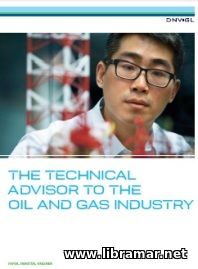 As the marine industry keeps adapting to the low oil prices era, the shipping companies face a completely new set of difficult challenges. They have to battle to contain the cost in various offshore operations and projects while, at the same time, they have to compete in a very competitive and increasingly flexible market of onshore services.
This happens along with the ongoing expansion of the LNG industry. This work is backed by over 150 years of the industry experience. In brief, this official DNV GL publication includes following major chapters - Facing up to a new normal - Technology foresight - Focused on the future - Building knowledge with bold ideas - Experts dedicated to making a difference - A broad service portfolio - Technical assurance... In addition to the above, it addresses the risk management advisory, some aspects of the offshore classification, various software solutions for the offshore industry as well as the services for project strategy, concept and feasibility.
The enterprise risk management services, concept and engineering support, safety and environmental risk management services and technology qualification and assessment have also been dealt with, along with the project verification and certification, project design services, due diligence and project risk management - as you can see, this small booklet contains quite a lot of useful info.
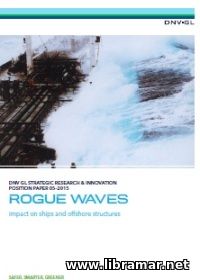 Rogue waves did always attract rapt attention of the researchers in the offshore and general shipping industries, in marine academia, and media during past years. These waves are also called freak/abnormal waves, or even giant waves, and are considered quite steep and also larger in comparison to the waves surrounding them.
There was a number of serious accidents which involved vessels and offshore installations - those incidents have been reported and discussed, and these waves were considered a reason; however, they not yet been included in the class society rules and recognized offshore standards. This paper was released to summarize the latest available information on rogue waves phenomena and its impact on ships as well as different marine structures. The authors have also focused on recent research projects in which this Class Society has participated.
Hopefully, this booklet will definitely provide readers with some better understanding on this weather phenomenon. In addition to that, the authors have proposed some future research activities required to support the inclusion of the rogue wave effects in the operational and design procedures related to the offshore structures and vessels, in particular. They have also emphasized the need for the warning criteria for such waves.
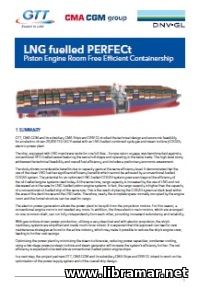 This booklet is dedicated to the new and revolutionary technology. The study of the technical design and economic feasibility for an electric-driven ULCV capable of transporting twenty thousand container units, with an LNG-fuelled combined cycle gas & stem turbine power plant, was conducted by GT, CMA CGM, CMA Ships and DNV GL Classification Society.
The vessel is equipped with the LNG membrane tanks for one full return voyage between Europe and Asia. The high-level research work performed by the above stated entities addresses the fuel efficiency and contains preliminary economic assessment. It is quite clear to everyone that LNG may be treated as the perfect fuel for gas turbines. It is very clean and allows to increase the turbine inlet temperature and, in turn, its efficiency. In addition, increased temperature at the turbine outlet allows to install the high-efficient steam turbine cycles using the exhaust gas coming from the turbine.
That is why COGAS, standing for the COmbined Gas and Steam Turbine way of generating power is considered one of the most effective ways - the efficiency of the power plants working on the LNG may achieve 60% which is unachievable level for the diesel engines, reaching to that 52% max.
« 1 2 ... 10 11 12 13 14 ... 29 30 » |







